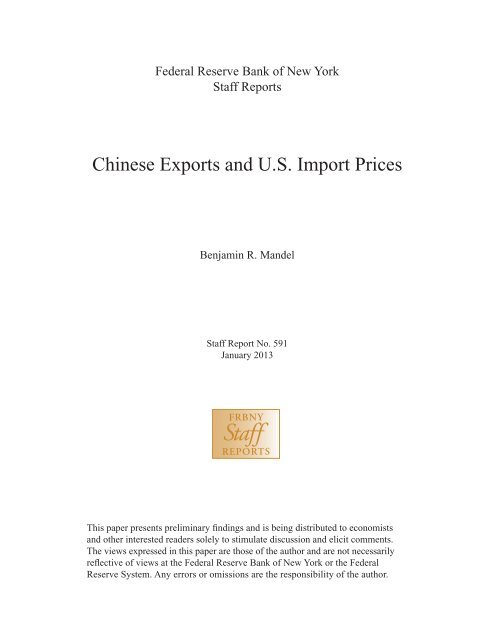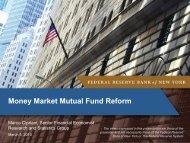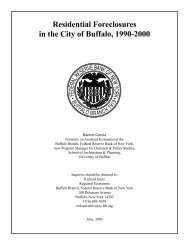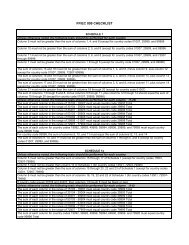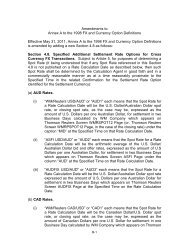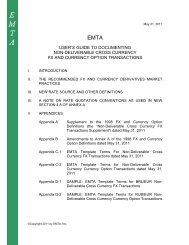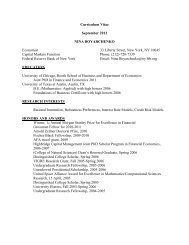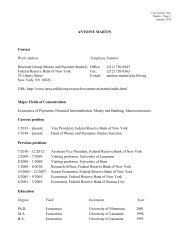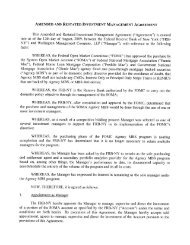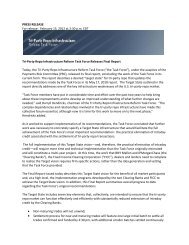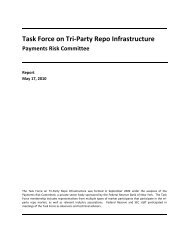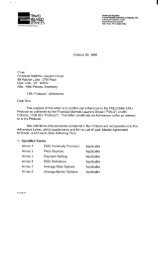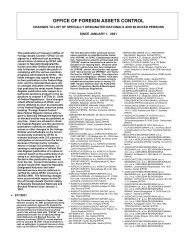Chinese Exports and U.S. Import Prices - Federal Reserve Bank of ...
Chinese Exports and U.S. Import Prices - Federal Reserve Bank of ...
Chinese Exports and U.S. Import Prices - Federal Reserve Bank of ...
You also want an ePaper? Increase the reach of your titles
YUMPU automatically turns print PDFs into web optimized ePapers that Google loves.
<strong>Federal</strong> <strong>Reserve</strong> <strong>Bank</strong> <strong>of</strong> New York<br />
Staff Reports<br />
<strong>Chinese</strong> <strong>Exports</strong> <strong>and</strong> U.S. <strong>Import</strong> <strong>Prices</strong><br />
Benjamin R. M<strong>and</strong>el<br />
Staff Report No. 591<br />
January 2013<br />
FRBNY<br />
Staff<br />
REPORTS<br />
This paper presents preliminary fi ndings <strong>and</strong> is being distributed to economists<br />
<strong>and</strong> other interested readers solely to stimulate discussion <strong>and</strong> elicit comments.<br />
The views expressed in this paper are those <strong>of</strong> the author <strong>and</strong> are not necessarily<br />
refl ective <strong>of</strong> views at the <strong>Federal</strong> <strong>Reserve</strong> <strong>Bank</strong> <strong>of</strong> New York or the <strong>Federal</strong><br />
<strong>Reserve</strong> System. Any errors or omissions are the responsibility <strong>of</strong> the author.
<strong>Chinese</strong> <strong>Exports</strong> <strong>and</strong> U.S. <strong>Import</strong> <strong>Prices</strong><br />
Benjamin R. M<strong>and</strong>el<br />
<strong>Federal</strong> <strong>Reserve</strong> <strong>Bank</strong> <strong>of</strong> New York Staff Reports, no. 591<br />
January 2013<br />
JEL classifi cation: F10, F14, L10<br />
Abstract<br />
This paper develops a technique to decompose price distributions into contributions from<br />
markups <strong>and</strong> marginal cost. The estimators are then used as a laboratory to measure the<br />
relationship between increasing <strong>Chinese</strong> competition <strong>and</strong> the components <strong>of</strong> U.S. import<br />
prices. The estimates suggest that the intensifi cation <strong>of</strong> <strong>Chinese</strong> exports in the 2000s<br />
corresponded to substantial changes in the distributions <strong>of</strong> both the markups <strong>and</strong> marginal<br />
cost <strong>of</strong> U.S. imports. The entry <strong>of</strong> a <strong>Chinese</strong> exporter in an industry corresponded to<br />
rest-<strong>of</strong>-world exporters shrinking their markup (lowering prices by up to 30 percent)<br />
<strong>and</strong> increasing their marginal cost (raising prices by up to 50 percent). The fact that<br />
marginal cost increased as competition stiffened strongly suggests that the composition<br />
<strong>of</strong> non-<strong>Chinese</strong> exports shifted toward higher-quality varieties. The estimates also imply<br />
a pattern in the acquisition <strong>of</strong> market share by <strong>Chinese</strong> exporters: They enter at relatively<br />
low cost/quality <strong>and</strong> then subsequently undertake quality improvements <strong>and</strong> markup<br />
reductions. These results provide some <strong>of</strong> the fi rst measures <strong>of</strong> the dual nature <strong>of</strong> trade’s<br />
procompetitive effects; exporters respond to tougher competition by simultaneously<br />
adjusting both markups <strong>and</strong> quality.<br />
Key words: Procompetitive effects <strong>of</strong> trade, markup measurement<br />
M<strong>and</strong>el: <strong>Federal</strong> <strong>Reserve</strong> <strong>Bank</strong> <strong>of</strong> New York (e-mail: benjamin.m<strong>and</strong>el@ny.frb.org). The author<br />
thanks Jonathan Hill <strong>and</strong> Leslie Shen for excellent research assistance. Mary Amiti, Robert<br />
Feenstra, <strong>and</strong> Katheryn Russ, as well as various conference <strong>and</strong> seminar participants, provided very<br />
helpful comments. The views expressed in this paper are those <strong>of</strong> the author <strong>and</strong> do not necessarily<br />
refl ect the position <strong>of</strong> the <strong>Federal</strong> <strong>Reserve</strong> <strong>Bank</strong> <strong>of</strong> New York or the <strong>Federal</strong> <strong>Reserve</strong> System.
One <strong>of</strong> the most remarkable changes in US international trade over the past two decades<br />
has been the increase in imports from China. China accounted for only 6 percent <strong>of</strong> total<br />
imports in the year 1995, increasing to 18 percent in 2011. This rise is equally impressive<br />
when looking at the intensive margin <strong>of</strong> trade, in which market share increased in the vast<br />
majority <strong>of</strong> products that China already exported at the beginning <strong>of</strong> the 2000s, or the<br />
extensive margin <strong>of</strong> trade, in which China increased the number <strong>of</strong> detailed product types it<br />
exported to the US by about 2,000 over the same period.<br />
China’s export growth has stimulated great interest in identifying <strong>and</strong> quantifying its<br />
e¤ects on competing producers <strong>and</strong> the welfare <strong>of</strong> US consumers. One important implication<br />
<strong>of</strong> a burgeoning China in markets operating under imperfect competition is that the markups<br />
charged by other …rms in the industry contract; this has been called a ‘pro-competitive’e¤ect<br />
<strong>of</strong> liberalization <strong>and</strong> the associated reduction <strong>of</strong> monopolistic rents is a potentially large<br />
source <strong>of</strong> gains from trade. A second pertinent implication <strong>of</strong> China’s entry <strong>and</strong> expansion<br />
in US import markets is the changing quality composition <strong>of</strong> the US consumption basket.<br />
While China’s growing market share indicates expenditure switching away from domestic<br />
sources <strong>and</strong> other exporters, we do not observe exactly to what extent <strong>Chinese</strong> merch<strong>and</strong>ise<br />
is comparable to, <strong>and</strong> hence substitutable for, goods from those other sources. This is an<br />
important consideration because the degree <strong>of</strong> quality di¤erentiation <strong>of</strong> import products <strong>and</strong><br />
the relative quality level <strong>of</strong> <strong>Chinese</strong> exports will have a direct bearing on production <strong>and</strong><br />
labor market outcomes due to import competition.<br />
In this paper, I develop a technique to jointly estimate the distribution <strong>of</strong> markups <strong>and</strong><br />
marginal cost across exporters, as well as the scope for quality di¤erentiation in an industry.<br />
I then use this estimator as a laboratory to measure the relationship between increasing<br />
<strong>Chinese</strong> import competition <strong>and</strong> the average markups charged by countries exporting to the<br />
United States, as well as on the average cost <strong>and</strong> quality <strong>of</strong> imports. I …nd that in industries<br />
which China entered into exporting, the declining markups <strong>of</strong> other producers accounted for<br />
price reductions <strong>of</strong> up to 30 percent in some sectors during the early to mid-2000s. These<br />
decreases in markups, which were particularly large for manufactures such as machinery, elec-<br />
tronics <strong>and</strong> transportation products, provide strong evidence <strong>of</strong> the pro-competitive e¤ects<br />
<strong>of</strong> trade. It is a …nding consistent with recent empirical work by Feenstra <strong>and</strong> Weinstein<br />
(2010), in which structural estimates <strong>of</strong> the e¤ects <strong>of</strong> globalization are estimated to reduce<br />
US consumer prices over a similar period, with a substantial share <strong>of</strong> the price decrease due<br />
1
to increased competition <strong>and</strong> reduced markups. De Loecker, Goldberg, Kh<strong>and</strong>elwal <strong>and</strong><br />
Pavcnik (2012) estimate that declines in output tari¤s in India reduced both the markups<br />
<strong>and</strong> prices <strong>of</strong> manufacturers. de Blas <strong>and</strong> Russ (2012) as well as Edmond, Midrigan <strong>and</strong> Xu<br />
(2012) demonstrate that changes in the distribution <strong>of</strong> markups due to decreasing trade costs<br />
can potentially lead to even larger welfare gains than earlier Ricardian models with variable<br />
markups. The present study builds on these results by quantifying the role <strong>of</strong> producers in<br />
the rest <strong>of</strong> the world (i.e., not only the domestic import-competing …rms) in responding to<br />
increasing competition by lowering their markups. As described below, the methodology I<br />
propose has the additional bene…ts <strong>of</strong> not relying on a particular form <strong>of</strong> consumer dem<strong>and</strong><br />
nor even requiring …rm-level data.<br />
In addition to changing markups, I also …nd that coincident with China’s entry into<br />
an industry, the marginal costs <strong>of</strong> non-<strong>Chinese</strong> exporters rose by up to 50 percent in some<br />
sectors during the early to mid-2000s. The fact that marginal costs increased as competi-<br />
tion sti¤ened strongly suggests that the composition <strong>of</strong> non-<strong>Chinese</strong> exports shifted towards<br />
higher quality varieties. An upgrading response to <strong>Chinese</strong> competition is hinted at by<br />
Schott (2008) using changes in China’s relative price within an industry. More generally,<br />
Amiti <strong>and</strong> Kh<strong>and</strong>elwal (2011) estimate that lower tari¤s were associated with faster qual-<br />
ity upgrading for the set <strong>of</strong> countries participating in US import industries. All <strong>of</strong> these<br />
…ndings imply that there is a pro-competitive e¤ect <strong>of</strong> trade on quality which is in addition<br />
to markups. Here, I provide some <strong>of</strong> the …rst joint measures <strong>of</strong> these dual pro-competitive<br />
e¤ects; exporters respond to tougher competition by simultaneously adjusting both markups<br />
<strong>and</strong> quality.<br />
Finally, the separation <strong>of</strong> prices into markups <strong>and</strong> marginal cost provides an estimate <strong>of</strong><br />
the composition <strong>of</strong> China’s prices. The results indicate that for non-commodity industries<br />
in which China entered, changes in the average price due to China were driven exclusively<br />
by China’s relative cost <strong>and</strong>/or quality <strong>and</strong> not its relative markup. On the other h<strong>and</strong>, for<br />
industries in which China was an incumbent exporter to the US, <strong>Chinese</strong> markups tended<br />
to decline relative to other competitors <strong>and</strong> China’s average cost <strong>and</strong>/or quality increased<br />
over time. These patterns suggest an intuitive dynamic in the acquisition <strong>of</strong> market share<br />
by <strong>Chinese</strong> …rms: namely, that they enter at relatively low cost <strong>and</strong>/or quality <strong>and</strong> then<br />
maintain <strong>and</strong> grow their share by undertaking quality improvements <strong>and</strong> decreasing their<br />
relative markup.<br />
2
The main methodological development below is the decomposition <strong>of</strong> average product-<br />
level prices into contributions from markups, quality, <strong>and</strong> productivity, <strong>and</strong> doing so without<br />
observing anything about speci…c imported varieties or exporting …rms except the average<br />
price from each source country. The additional information used for identi…cation <strong>of</strong> the<br />
components <strong>of</strong> price comes from the set <strong>of</strong> higher moments <strong>of</strong> the import price distribution<br />
for each product. Speci…cally, in addition to the average product price, country-speci…c unit<br />
values are used to measure the variance <strong>and</strong> skewness <strong>of</strong> prices within each product group.<br />
The mean, variance <strong>and</strong> skewness <strong>of</strong> prices, in turn, are re‡ections <strong>of</strong> the combination <strong>of</strong><br />
underlying distributions <strong>of</strong> markups <strong>and</strong> marginal costs across export sources, <strong>and</strong> I solve<br />
for the parameters <strong>of</strong> those distributions in terms <strong>of</strong> the observed moments <strong>of</strong> prices.<br />
Using higher moments is a departure from previous attempts to infer product quality<br />
<strong>and</strong> productivity from prices, which have tended to focus on the …rst moment (the mean) <strong>of</strong><br />
prices combined with information on quantities, inputs or income. For example, Hallak <strong>and</strong><br />
Schott (2010), Kh<strong>and</strong>elwal (2010) <strong>and</strong> Gervais (2011) use the trade balance, market share,<br />
<strong>and</strong> output quantity, respectively, conditional on average price, as proxies for export quality.<br />
In Feenstra <strong>and</strong> Romalis (2012) non-homothetic preferences <strong>and</strong> speci…c transport costs<br />
give rise to an expression for quality that is proportional to the exporter’s price divided by a<br />
productivity-adjusted wages. Johnson (2011) <strong>and</strong> Baldwin <strong>and</strong> Harrigan (2011) demonstrate<br />
that average export prices are increasing in the di¢ culty <strong>of</strong> entering or reaching a destination<br />
market, consistent with high quality …rms being the most competitive ones. Kugler <strong>and</strong><br />
Verhoogen (2011), Manova <strong>and</strong> Zhang (2011) <strong>and</strong> Verhoogen (2008) argue that export prices<br />
are related to input prices via the choice <strong>of</strong> product quality, which tends to be increasing<br />
in …rm capability. Finally, Hummels <strong>and</strong> Klenow (2002) <strong>and</strong> Hallak (2010) illustrate the<br />
usefulness <strong>of</strong> quality heterogeneity in relating country size to export prices <strong>and</strong> the size <strong>of</strong><br />
trade ‡ows.<br />
<strong>Import</strong>antly, the studies above largely abstract from the in‡uence <strong>of</strong> variable markups<br />
across exporters on the pattern <strong>of</strong> prices. 1 In a similar manner, studies measuring the<br />
markups <strong>of</strong> exporting …rms also tend to do so in isolation <strong>of</strong> the in‡uence <strong>of</strong> quality on<br />
average prices. Recent examples <strong>of</strong> markup estimation in the international trade literature<br />
1 To be sure, in some instances the patterns generated by quality di¤erentiation are di¤erent than one<br />
would expect due to variation in markups. In those cases it is possible to distinguish, at least qualitatively,<br />
between price e¤ects due to quality <strong>and</strong> markups. However, since none <strong>of</strong> these studies attempts to measure<br />
markups, they are silent on the exact quantitative relationship between these factors <strong>and</strong> prices.<br />
3
include De Loecker <strong>and</strong> Warzynski’s (2010) plant-level estimates for Slovenian manufacturers,<br />
as well as Feenstra <strong>and</strong> Weinstein (2010), mentioned above. In either case, either the<br />
empirical identi…cation or underlying model is not one which explicitly accounts for quality<br />
di¤erentiation. 2<br />
The intuition for my joint estimation <strong>of</strong> an industry’s markups, marginal cost <strong>and</strong> quality<br />
di¤erentiation is that the observed distribution <strong>of</strong> international trade prices is the sum <strong>of</strong><br />
the underlying distributions <strong>of</strong> markups <strong>and</strong> marginal costs, where the costs include those<br />
embodied in higher quality varieties in addition to other input costs. Estimating the dis-<br />
tribution <strong>of</strong> markups <strong>and</strong> the distribution <strong>of</strong> marginal cost thus requires one to assume<br />
knowledge <strong>of</strong> the shape <strong>of</strong> the markup <strong>and</strong> productivity distributions in each industry. This<br />
assumption will ground the resulting estimates in a well-documented empirical fact: the size<br />
distribution <strong>of</strong> …rms in an industry tends to follow a power law or similarly fat-tailed distri-<br />
bution. Buttressing this fact are studies <strong>of</strong> …rm-level data which have found a signi…cant<br />
<strong>and</strong> persistent degree <strong>of</strong> concentration <strong>of</strong> sales in the largest …rms (Axtell, 2001), that this<br />
concentration is related to the decision to export (Bernard <strong>and</strong> Jensen (1999), onwards). 3<br />
Taken together, these facts imply an exporter size distribution with a long right tail. Theo-<br />
retical contributions have taken these cues <strong>and</strong> have speci…ed the underlying distribution <strong>of</strong><br />
…rm productivity accordingly: Weibull in the case <strong>of</strong> Eaton <strong>and</strong> Kortum (2002), or Pareto<br />
in the case <strong>of</strong> Melitz (2003). Here, we will assume that the underlying productivity dis-<br />
tribution <strong>of</strong> …rms follows a Pareto distribution <strong>and</strong> then analyze the estimates <strong>of</strong> average<br />
markups <strong>and</strong> marginal costs under various assumptions about the distribution <strong>of</strong> markups<br />
across exporters.<br />
The paper is organized as follows. The next section describes the impact <strong>of</strong> China’s<br />
exports on the distribution <strong>of</strong> US import prices. Section 2 derives estimators that use<br />
the moments <strong>of</strong> the import price distribution to decompose prices into markup <strong>and</strong> quality<br />
components. Then, Section 4 uses the estimates to examine China’s contribution to changes<br />
in markups <strong>and</strong> the product quality <strong>of</strong> US imports. Section 5 concludes.<br />
2 De Loecker, Goldberg, Kh<strong>and</strong>elwal <strong>and</strong> Pavcnik (2012) is an exception in that input prices are modelled<br />
as a function <strong>of</strong> quality di¤erences across outputs.<br />
3 di Giovanni, Levchenko <strong>and</strong> Rancière (2011) argue that the …rm size distribution is itself a function <strong>of</strong> the<br />
intensity <strong>of</strong> international trade. Nontheless, in their setup the distribution <strong>of</strong> exporters <strong>and</strong> non-exporters<br />
are both characterized by a power-law.<br />
4
1 China’s e¤ect on the distribution <strong>of</strong> US import prices<br />
In this section, the e¤ect <strong>of</strong> <strong>Chinese</strong> exports on the distribution <strong>of</strong> US import prices is<br />
documented. <strong>Import</strong> prices are de…ned at the level <strong>of</strong> detailed products <strong>and</strong> source countries<br />
using US customs data on import values <strong>and</strong> quantities. 4 The average unit value for a given<br />
product (indexed by j), exporting country (indexed by i), <strong>and</strong> frequency (indexed by t) is:<br />
p j<br />
i =<br />
X2006<br />
M<br />
t=2002<br />
j<br />
it<br />
X2006<br />
Q j<br />
it<br />
t=2002<br />
where M j<br />
it <strong>and</strong> Qjit<br />
are the annual dollar value <strong>and</strong> quantity, respectively, <strong>of</strong> bilateral imports<br />
for a Harmonized System 10-digit product (HS10). It will be very important below to<br />
obtain an accurate measure <strong>of</strong> the cross-sectional distribution <strong>of</strong> import prices across source<br />
countries. Therefore, in order to mitigate some <strong>of</strong> the noisiness <strong>of</strong> the data at that …ne<br />
a level <strong>of</strong> product aggregation (for example, due to infrequent trading), a relatively broad,<br />
…ve year time frame is adopted, from 2002 through 2006. Another reason to choose these<br />
dates is that 2002 <strong>and</strong> 2007 corresponded to broad changes in the HS10 classi…cation scheme,<br />
which makes the intervening interval the most comparable over time. Consistent with other<br />
studies, we do a basic cleaning <strong>of</strong> the data by dropping any observations with Q j<br />
it<br />
M j<br />
it < $10; 000.<br />
5<br />
= 0 or<br />
We begin with the observation that China is nearly ubiquitous in US import product<br />
space over the period 2002-6. As detailed in Table 1, <strong>of</strong> the 15,980 HS10 products in the<br />
US customs data, China participated in 76 percent. That is, at least one year between<br />
2002 <strong>and</strong> 2006 was characterized by <strong>Chinese</strong> imports greater than $10,000 in over three<br />
quarters <strong>of</strong> product categories. Weighting the count <strong>of</strong> products by import value, the<br />
rate <strong>of</strong> <strong>Chinese</strong> import participation rises to 87 percent. It is also noteworthy that the<br />
share <strong>of</strong> products with <strong>Chinese</strong> exports tends to vary a lot by sector, with agricultural <strong>and</strong><br />
commodity products having relatively lower rates. Textiles, apparel <strong>and</strong> industrial products<br />
such as machinery <strong>and</strong> plastics had among the highest rates, followed by stones, metals <strong>and</strong><br />
chemicals. In general, <strong>Chinese</strong> participation tended to be higher in more di¤erentiated<br />
4 The data source is described in Feenstra, Romalis <strong>and</strong> Schott (2002).
manufactures relative to more homogeneous commodities.<br />
In addition to broad participation in US imports categories, <strong>Chinese</strong> exports exert sub-<br />
stantial in‡uence on the distribution <strong>of</strong> prices within those categories. Table 2 displays the<br />
average mean <strong>and</strong> st<strong>and</strong>ard deviation <strong>of</strong> HS10 prices within each sector, computed both with<br />
<strong>and</strong> without China. The di¤erence between the with <strong>and</strong> without statistics is a measure <strong>of</strong><br />
the average contribution <strong>of</strong> China to the level <strong>and</strong> dispersion <strong>of</strong> prices. On average, the level<br />
<strong>of</strong> US import prices in a category was 2.2 percent lower <strong>and</strong> the st<strong>and</strong>ard deviation was 0.5<br />
percent higher due to China. These e¤ects tended to be most pronounced in the sectors with<br />
the highest China participation as well as those with the highest level <strong>of</strong> di¤erentiation. One<br />
can think <strong>of</strong> the dispersion <strong>of</strong> prices within an HS10 as a proxy for its level <strong>of</strong> di¤erentiation,<br />
since large prices among homogeneous varieties should largely be arbitraged away. Indeed,<br />
the largest price e¤ects due to China are in the four sectors with average price dispersion <strong>of</strong><br />
over 100 log points.<br />
We also observe that the contribution <strong>of</strong> US imports from China to average product price<br />
is related systematically to their e¤ect on price dispersion; products in which China’s e¤ect<br />
on average prices is high are those in which China’s contribution to dispersion are also high.<br />
As illustrated in Figure 1, in the majority <strong>of</strong> HS10 products in which China participated –<br />
10,312 out <strong>of</strong> 12,170 to be precise –China prices pulled down the average product price (i.e.,<br />
the di¤erence between average price with <strong>and</strong> without China is negative). Further, the more<br />
negative was China’s relative price, the greater was its contribution to the variance <strong>of</strong> prices<br />
for that product. This was also the case in the minority <strong>of</strong> instances in which China had a<br />
relatively high price compared with other countries: higher relative prices corresponded to a<br />
higher contribution to price dispersion.<br />
Finally, we document the contribution <strong>of</strong> <strong>Chinese</strong> export unit values to overall US import<br />
price changes over time, <strong>and</strong> …nd that it was much more pronounced in industries that China<br />
recently entered relative to incumbent industries. In other words, China contributed most<br />
to unit value changes in the products it began exporting to the US over the 2002 to 2006<br />
period. To evaluate price changes over time, we compute similar statistics for the 1997-2001<br />
period <strong>and</strong> then match those to industries in the 2002-6 period. 5 The top panel <strong>of</strong> Table<br />
5 Given the changes made to the HS classi…cation in 2002, we attempt several di¤erent matching schemes<br />
<strong>of</strong> products in the early <strong>and</strong> later periods. The simplest, <strong>and</strong> the one which is presented, is to treat the<br />
products in the early <strong>and</strong> late periods as strictly comparable. An alternative classi…cation scheme which<br />
6
3 shows the contribution <strong>of</strong> China to price changes between the early <strong>and</strong> late periods, for<br />
products in which China participated in both periods. Both overall <strong>and</strong> across sectors, the<br />
di¤erence between average price changes computed with <strong>and</strong> without China is modest, even<br />
in industries with rather large price changes in absolute terms. China’s average contribution<br />
to import price changes for an HS product was -0.2 percent. This story is drastically di¤erent<br />
when we restrict our attention to the roughly 2,000 products that the US began importing<br />
from China in the more recent period. For those categories, China contributed an average<br />
<strong>of</strong> -5.2 percent to import price changes at the HS10 level.<br />
It is also case that the mean <strong>and</strong> st<strong>and</strong>ard deviation <strong>of</strong> US import price changes due to<br />
China are systematically related, though this relationship depends on whether China recently<br />
entered the import market. The bottom panel <strong>of</strong> Figure 2 shows the same ‘V’pattern for<br />
price changes <strong>of</strong> recently entered products as Figure 1 exhibited for price levels. That is,<br />
larger price changes due to China corresponded to larger increases in price dispersion due to<br />
China. However, for the set <strong>of</strong> products in which China participated during both periods,<br />
this relationship is no longer apparent, shown in the top panel <strong>of</strong> Figure 2. Even when<br />
China contributed substantially to price increases or declines, it did not do so in a way that<br />
systematically altered the dispersion prices in a product.<br />
2 Estimating markups, productivity <strong>and</strong> quality<br />
Having established that exports from China have had a meaningful e¤ect on the distribution<br />
<strong>of</strong> US import prices, in this section method <strong>of</strong> moments estimators are derived for the<br />
marginal cost <strong>and</strong> markup components <strong>of</strong> import prices as a function <strong>of</strong> that distribution.<br />
Starting from the identity:<br />
where<br />
ln pi = ln i + ln MCi<br />
7<br />
(1)<br />
ln MCi = ln ' i; (2)<br />
' i is a measure <strong>of</strong> country-speci…c productivity <strong>and</strong> i is that country’s average markup, the<br />
objective is to decompose the observed moments <strong>of</strong> prices into a distribution for markups,<br />
accounts for HS changes over time (suggested by Pierce <strong>and</strong> Schott, 2012) is also implemented, though the<br />
qualitative <strong>and</strong> quantitative exercises below are little changed as a result.
a distribution for productivity, <strong>and</strong> the covariance <strong>of</strong> markups <strong>and</strong> productivity. The pa-<br />
rameter is the elasticity <strong>of</strong> marginal cost to productivity, <strong>and</strong> can be interpreted as the<br />
length <strong>of</strong> each product’s quality ladder. In relatively homogeneous products, is negative<br />
<strong>and</strong> high productivity exporters set relatively low prices; vice versa applies for products with<br />
a high degree <strong>of</strong> quality di¤erentiation.<br />
Given this de…nition <strong>of</strong> price, the …rst three moments <strong>of</strong> prices within a given product<br />
group can be expressed generically as: 6<br />
E[ln pi] = E[ln i] + E[ln ' i] (3)<br />
V ar[ln pi] = V ar[ln i] + 2 V ar[ln 'i] + 2 cov[ln i; ln 'i] (4)<br />
Skew[ln pi]<br />
3<br />
V ar[ln pi] 2<br />
u Skew[ln i]<br />
3 +<br />
V ar[ln 2 i]<br />
3 +<br />
Skew[ln 'i] 3<br />
V ar[ln ' 2 i]<br />
3 cov[ln i; ln 'i] 3<br />
2<br />
V ar[(ln pi)]<br />
2<br />
3<br />
2 V ar[ln i] 2 3<br />
2 V ar[ ln 'i] 2<br />
(5)<br />
The second expression is the familiar decomposition <strong>of</strong> a variance into the variance <strong>of</strong> its<br />
components <strong>and</strong> their covariance. Analogously, the third expression splits the skewness <strong>of</strong> log<br />
prices into contributions from the skewness <strong>of</strong> log markups, the skewness <strong>of</strong> log productivity<br />
<strong>and</strong> a number <strong>of</strong> cross terms approximated by the variances <strong>and</strong> covariance. Of course, the<br />
moments <strong>of</strong> the markup <strong>and</strong> productivity distributions, not to mention , are unobserved in<br />
the international trade data. To achieve identi…cation, enough restrictions need to be made<br />
so as to reduce the number <strong>of</strong> unknowns on the right-h<strong>and</strong> side to three.<br />
We consider two types <strong>of</strong> restrictions: distributional <strong>and</strong> parametric. The distributional<br />
assumptions take a st<strong>and</strong> on the shape <strong>of</strong> the productivity <strong>and</strong> markup distributions; as-<br />
sumptions <strong>of</strong> this sort reduce the dimensionality <strong>of</strong> the right-h<strong>and</strong> side variables by expressing<br />
each moment <strong>of</strong> a distribution in terms <strong>of</strong> the smaller number <strong>of</strong> that distribution’s parame-<br />
ters. These assumptions also leverage prior empirical studies documenting the shape <strong>of</strong> the<br />
…rm size distribution. The second group <strong>of</strong> restrictions consists <strong>of</strong> additional assumptions<br />
about the parameters <strong>of</strong> the markup <strong>and</strong> productivity distribution. These assumptions are<br />
grounded in theory in the sense that di¤erent assumptions about the consumer’s dem<strong>and</strong><br />
6 See the appendix for the derivation <strong>of</strong> (5).<br />
8
curve or the …rm’s production function are consistent with di¤erent con…gurations <strong>of</strong> mo-<br />
ment restrictions. In the following two sub-sections, we will work with the moment equations<br />
(3)-(5) under various assumptions about the markup <strong>and</strong> productivity distributions across<br />
exporters.<br />
2.1 Case I: Constant markups <strong>and</strong> heterogeneous quality across<br />
exporters (i.e., CES plus quality di¤erentiation)<br />
In order to build intuition for how the estimator works, our …rst case applies the most<br />
restrictive distributional assumption about the range <strong>of</strong> markups across exporters. Let us<br />
assume that the utility function for a given product group is a constant elasticity aggregate <strong>of</strong><br />
varieties in that product group. This assumption implies that markups are a constant across<br />
exporters (E[ln i] = ln ; ri) <strong>and</strong> it follows immediately that V ar[ln i] = 0, Skew[ln i] = 0,<br />
<strong>and</strong> cov[ln i; ln ' i] = 0, which reduces the moment equations above to:<br />
E[ln pi] = ln + E[ln ' i] (6)<br />
Med[ln pi] = ln + Med[ln 'i] (7)<br />
Skew[ln pi]<br />
3<br />
V ar[ln pi] 2<br />
= 3 Skew[ln 'i] 3<br />
V ar[ln ' 2 i]<br />
(8)<br />
Since the markup distribution degenerates to a point, ln , the shape <strong>of</strong> the price distribution<br />
is driven exclusively by the shape <strong>of</strong> the productivity distribution. The last line uses the fact<br />
that V ar[ln pi] = V ar[ ln ' i] to express the skewness <strong>of</strong> prices only in terms <strong>of</strong> the skewness<br />
<strong>of</strong> the productivity distribution <strong>and</strong> the cube <strong>of</strong> the quality scope parameter . Also note<br />
that when the only source <strong>of</strong> variation across …rms is productivity, the median can also be<br />
used as an additional equation in the system.<br />
Our choice <strong>of</strong> distribution for productivity borrows from the stylized fact that …rm sizes<br />
within an industry are distributed according to (or close to) a power-law. Therefore, we<br />
shall assume that the log <strong>of</strong> productivity is exponentially distributed with shape parameter<br />
: ln ' exp( ), > 0. This assumption would be exactly correct if ' followed a Pareto<br />
distribution with scale parameter 1 <strong>and</strong> shape parameter . Assuming that ' pareto(1; )<br />
9
implies that ln ' exp( ) with inverse scale parameter <strong>and</strong> probability density function:<br />
f(ln '; ) = e<br />
The equations above can then be re-expressed in terms <strong>of</strong> the parameter .<br />
ln '<br />
10<br />
(9)<br />
E[ln pi] = ln + (10)<br />
Med[ln pi] = ln + ln 2 (11)<br />
Skew[ln pi]<br />
V ar[ln pi]<br />
3<br />
2<br />
= 2<br />
which is an overidenti…ed system <strong>of</strong> 3 equations in 2 unknowns: ln <strong>and</strong> . The interpre-<br />
tation <strong>of</strong> ln is the average (log) markup for a particular HS10 product. The object is<br />
a composite <strong>of</strong> the quality ladder length parameter, , <strong>and</strong> the inverse scale parameter <strong>of</strong><br />
the productivity distribution, 1 ; we can interpret this object as the dispersion <strong>of</strong> marginal<br />
costs in a product group either driven by the extent <strong>of</strong> quality di¤erentiation or di¤erences in<br />
…rm ability. Yet another way <strong>of</strong> saying this is that is a proxy for product di¤erentiation,<br />
whether vertical ( ) or horizontal ( 1 ).<br />
Note that although the sign <strong>of</strong> is determined by , the magnitudes <strong>of</strong> the numerator<br />
<strong>and</strong> denominator are not separately identi…able. That is to say, the scale parameter <strong>of</strong> the<br />
productivity distribution <strong>and</strong> the scope for quality di¤erentiation in an industry a¤ect the<br />
price distribution in similar ways. Solving the …rst two equations for ln <strong>and</strong> yields the<br />
following closed form solutions for the estimators:<br />
b<br />
=<br />
E[ln pi]<br />
(1<br />
Med[ln pi]<br />
ln 2)<br />
dln = Med[ln pi]<br />
(ln 2)<br />
E[ln pi]:<br />
(1 ln 2)<br />
3<br />
(12)
2.2 Case II: Variable markups <strong>and</strong> heterogeneous quality across<br />
exporters<br />
Our second case is much more general, in that it allows for heterogeneous productivity,<br />
markups <strong>and</strong> quality across exporting …rms. Again, identi…cation <strong>of</strong> the underlying produc-<br />
tivity distribution, markup distribution <strong>and</strong> the sign <strong>of</strong> the quality elasticity is achieved by<br />
assuming a shape for both the productivity <strong>and</strong> markup distributions. We maintain our<br />
assumption from above that ln ' exp( ').<br />
One’s prior for the shape <strong>of</strong> the distribution <strong>of</strong> markups across …rms is somewhat less<br />
developed, though an important class <strong>of</strong> recent models with variable markups have sug-<br />
gested that is also looks much like a Pareto. In de Blas <strong>and</strong> Russ (2012) an extension <strong>of</strong><br />
the Bernard, Eaton, Jensen <strong>and</strong> Kortum (2003) model featuring Pareto productivity un-<br />
der Bertr<strong>and</strong> competition gives rise to a Pareto distribution <strong>of</strong> markups. In Atkeson <strong>and</strong><br />
Burstein (2008), Cournot competition gives rise to a density <strong>of</strong> markups which looks sim-<br />
ilar to a Pareto distribution. Thus, we shall assume that markups also follow a Pareto<br />
distribution which implies: ln exp( ), > 0.<br />
The moment equations can now be re-expressed in terms <strong>of</strong> the parameters <strong>of</strong> these two<br />
exponential distributions: 7<br />
E[ln pi] = 1 + '<br />
V ar[ln pi] =<br />
Skew[ln pi]<br />
V ar[ln pi]<br />
3<br />
2<br />
u 2<br />
1<br />
+ 3<br />
2<br />
1<br />
2<br />
1<br />
+<br />
3<br />
+ 2<br />
2<br />
'<br />
2<br />
'<br />
+ 2 cov[ln i; ln ' i]<br />
3<br />
+ 3<br />
2 '<br />
2<br />
3 cov[ln i; ln ' i]<br />
3<br />
V ar[ln pi]<br />
2<br />
Taken together, the mean, variance <strong>and</strong> skewness <strong>of</strong> prices are a system <strong>of</strong> three equa-<br />
tions in three unknowns: ,<br />
' <strong>and</strong> cov[ln 1<br />
i; ln 'i]. Substituting = E[ln pi] <strong>and</strong><br />
'<br />
cov[ln i; ln 'i] = 1<br />
2V ar[ln pi]<br />
2<br />
2<br />
1 1 1 into the …nal expression gives a quadratic<br />
2<br />
2 '<br />
7 See Appendix for a more detailed derivation <strong>of</strong> the skewness decomposition.<br />
11
equation in terms <strong>of</strong> only 1 <strong>and</strong> the observed moments <strong>of</strong> prices:<br />
0 = 6 [E[ln pi] + 1]<br />
+3E[ln pi] 2 + 2E[ln pi] 3<br />
1<br />
2<br />
6 E[ln pi] 2 + E[ln pi] 1<br />
12<br />
Skew[ln pi]V ar[ln pi] 3<br />
2 3V ar[ln pi] (13)<br />
The solution algorithm to this system <strong>of</strong> equations yields the roots <strong>of</strong> the above equation<br />
subject to the constraints: > 0 2 R <strong>and</strong> ' > 0 2 R.<br />
2.3 Case III: Allowing for measurement error in prices<br />
As we will see below, there are a large number <strong>of</strong> HS10 import industries that do not<br />
have an exact, real solution for the Case II estimator (13). One reason that may occur is<br />
that the observed moments <strong>of</strong> import prices are imperfect measures <strong>of</strong> the true underlying<br />
import price distribution. I deal with the possibility <strong>of</strong> measurement error by simulating<br />
the markup <strong>and</strong> productivity distributions for a range <strong>of</strong> plausible parameter values. The<br />
preferred combination <strong>of</strong> parameters for each industry will be the one that minimizes the<br />
Euclidean distance between the implied price distribution <strong>and</strong> the observed one.<br />
To be concrete, let us consider a very simple type <strong>of</strong> error where only the mean price<br />
(E[ln pi]) is mismeasured by a scalar "1. Each subsequent moment equation would be biased<br />
by an increasing power <strong>of</strong> "1; variance would be mismeasured by some function f(" 2 1), <strong>and</strong><br />
skewness would be mismeasured by some function f(" 3 1). This follows directly from the<br />
fact that the variance <strong>of</strong> prices is a function <strong>of</strong> the square <strong>of</strong> E[ln pi], <strong>and</strong> the skewness <strong>of</strong><br />
prices is a function <strong>of</strong> the cube <strong>of</strong> E[ln pi]. I perform a search <strong>of</strong> the grid: 1 = [ 0:2; 2:0],<br />
' = [ 2:0; 2:0], <strong>and</strong> cov[ln i; ln ' i] = [ 2:0; 2; 0], by increments <strong>of</strong> 0:1 within each parameter<br />
range. The optimal combination <strong>of</strong> parameters for each industry minimizes the sum<br />
<strong>of</strong> squared errors across the three moment equations, where the error <strong>of</strong> each subsequent mo-<br />
ment is adjusted downwards exponentially so as not to overweight the errors <strong>of</strong> the higher<br />
moments:<br />
min ("1)<br />
1<br />
; ; cov[ln<br />
' i ;ln 'i ]<br />
2<br />
1 + f(" 2 1) 2<br />
2 + f(" 3 1) 2<br />
3 (14)
The solution for the parameters <strong>of</strong> each industry satis…es (14), <strong>and</strong> I will consider only those<br />
solutions that lie on the interior <strong>of</strong> the grid space.<br />
2.4 Evaluating the Case I-III estimators<br />
Applying the estimators to the moments <strong>of</strong> the import price distribution, we can now evalu-<br />
ate the resulting markups <strong>and</strong> di¤erentiation estimates against a selection <strong>of</strong> empirical <strong>and</strong><br />
theoretical benchmarks. The …rst question one might ask is whether the estimated magni-<br />
tude <strong>of</strong> markups is reasonable in comparison to previous studies. One suitable benchmark<br />
is a study by De Loecker <strong>and</strong> Warzynski (forthcoming), which provides several estimates <strong>of</strong><br />
markups for Slovenian manufacturing plants based on a number <strong>of</strong> methodologies. Their<br />
estimates range from 1.03 to 1.12 using the methodologies <strong>of</strong> Hall (1986) <strong>and</strong> Klette (1999),<br />
respectively, to 1.2 using their own approach which extends Hall’s to include a control for<br />
unobserved changes in plant productivity. They also …nd the variance across plants to be<br />
quite high <strong>and</strong> that exporters tend to have higher markups, on average, than non-exporters.<br />
Our estimates <strong>of</strong> average markups for US import industries will di¤er in their scope <strong>and</strong><br />
composition; US imports include a much wider array <strong>of</strong> sectors, broader than only manu-<br />
facturing, <strong>and</strong> we are additionally restricted to observing the subset <strong>of</strong> prices for exporting<br />
foreign …rms.<br />
The second criterion by which to judge our estimators is the relationship between markups<br />
<strong>and</strong> the degree <strong>of</strong> product di¤erentiation, which we would expect to be positive: more dif-<br />
ferentiation corresponds to greater market power for each individual exporter, which should<br />
translate into higher average markups. Recall that our estimate <strong>of</strong> product di¤erentiation<br />
is the set <strong>of</strong> parameters . The clearest case <strong>of</strong> the relationship between markups <strong>and</strong> dif-<br />
'<br />
ferentiation is for industries with long quality ladders ( > 0): for that range <strong>of</strong> parameters,<br />
both higher <strong>and</strong> 1<br />
'<br />
indicate a higher level <strong>of</strong> product di¤erentiation. The relationship is<br />
ambiguous for less quality di¤erentiated industries ( < 0), however, since over that range a<br />
larger magnitude <strong>of</strong> implies less quality di¤erentiation <strong>and</strong> lower markups, whereas higher<br />
1<br />
'<br />
still implies more productivity dispersion <strong>and</strong> higher markups.<br />
The third criterion for evaluating the estimators is the number <strong>of</strong> products with long<br />
quality ladders versus short quality ladders. This criterion is related to prior research<br />
showing that average export prices are increasing in exporter productivity <strong>and</strong> destination<br />
13
income. Since these statistics are indicative <strong>of</strong> quality di¤erentiated industries –speci…cally,<br />
industries where the elasticity <strong>of</strong> marginal cost to productivity is positive –they imply that,<br />
on balance, there are more quality di¤erentiated industries than less quality di¤erentiated<br />
industries. That is, the number <strong>of</strong> industries with > 0 is greater than the number with<br />
< 0. 8<br />
Estimates from the Case I <strong>and</strong> Case II speci…cations are shown in Figure 3, where each<br />
histogram illustrates the density <strong>of</strong> markups (exp( 1 )) <strong>and</strong> product di¤erentiation ( ' ) across<br />
HS10 industries. The top panels, using the CES-based speci…cation, illustrates several<br />
inconsistencies between the estimates <strong>and</strong> the criteria above for reasonable estimates. For<br />
one, there are a large number <strong>of</strong> observations with either markups <strong>of</strong> less than one, or else<br />
markups which are implausibly high. The median estimate across all 15,094 HS10 products<br />
in the 2002-2006 period is 7.60, over 5 times higher than one would expect based on the<br />
high end <strong>of</strong> the range <strong>of</strong> estimates in De Loecker <strong>and</strong> Warzynski. The second criterion is<br />
also not met by the CES-based estimator, since there is a negative estimated relationship<br />
between product di¤erentiation <strong>and</strong> markups for the entire range <strong>of</strong> .<br />
'<br />
This statistic<br />
is summarized by the regression estimates in the top panel <strong>of</strong> Table 4. For each <strong>of</strong> the<br />
periods <strong>and</strong> for both positive <strong>and</strong> negative values <strong>of</strong> , markups are lower for higher levels<br />
'<br />
<strong>of</strong> product di¤erentiation with an elasticity <strong>of</strong> around -1 for quality di¤erentiated industries<br />
<strong>and</strong> around -2.3 for less quality di¤erentiated industries. Moreover, the relationship is quite<br />
stable across time periods. Despite these shortcomings, the Case I estimator does do well in<br />
predicting that there are more quality di¤erentiated industries than less-quality di¤erentiated<br />
industries. In summary, while CES estimator has the advantage <strong>of</strong> extreme tractability<br />
(producing estimates for every industry) <strong>and</strong> allocates industries’quality di¤erentiation in<br />
line with prior expectations, it misses along several other key dimensions.<br />
The bottom panels show the results for the more ‡exible Case II estimator. In this case,<br />
there are only 3,937 products with real <strong>and</strong> positive solutions for both 1 <strong>and</strong> ' . Despite<br />
the fact that only a minority <strong>of</strong> the roughly 15 thous<strong>and</strong> HS10 products have solutions,<br />
however, the estimates that were obtained fall much more closely in line with the criteria<br />
above. The median markup is 1.79, which is on the high end <strong>of</strong> the range in De Loecker <strong>and</strong><br />
8 Consistent with this criterion, prior estimates <strong>of</strong> quality ladder length using trade data but di¤erent<br />
identi…cation schemes, such as Kh<strong>and</strong>elwal (2010) <strong>and</strong> Baldwin <strong>and</strong> Ito (2008), have found substantial<br />
numbers <strong>of</strong> products with long quality ladders.<br />
14
Warzynski, but is quite plausible for the subset <strong>of</strong> exporters. The estimator also displays<br />
the expected positive relationship between markups <strong>and</strong> product di¤erentiation for<br />
Interestingly, the relationship between markups <strong>and</strong> di¤erentiation reverses sign depending<br />
on the level <strong>of</strong> quality di¤erentiation, as shown in the middle panel <strong>of</strong> Table 4. While<br />
the overall correlation between di¤erentiation is negative <strong>and</strong> signi…cant, there is a clear<br />
distinction between industries with high quality di¤erentiation, where the relationship is<br />
positive <strong>and</strong> signi…cant, <strong>and</strong> the more homogeneous industries. This result is consistent<br />
with the notion that a higher degree <strong>of</strong> dispersion in …rm productivity translates into higher<br />
markups, even in industries that have little quality di¤erentiation. On the third criterion,<br />
in contrast to Case I, the Case II estimator predicts that there are fewer industries with long<br />
quality ladders relative to those with short quality ladders, shown in the bottom-right panel<br />
<strong>of</strong> Figure 3. However, note the possibility that the small number <strong>of</strong> industries with solutions<br />
may be in‡uencing this statistic. The Case III estimator will …nd solutions for many more<br />
industries under the same distributional assumptions.<br />
We can use an additional criterion to evaluate the reasonableness <strong>of</strong> the Case I <strong>and</strong> II<br />
estimators, the covariance between markups <strong>and</strong> productivity. Recall that one <strong>of</strong> the outputs<br />
to the solution algorithm in the previous section was cov[ln i; ln ' i]. While there are very<br />
few empirical benchmarks for this relationship, most theories permitting variable markups<br />
across …rms (such as Melitz <strong>and</strong> Ottaviano (2008) <strong>and</strong> Feenstra <strong>and</strong> Weinstein (2010)) imply<br />
that it is positive. That is because more productive …rms obtain higher market share in an<br />
industry <strong>and</strong> hence comm<strong>and</strong> more market power <strong>and</strong> a higher markup. Although the CES-<br />
based estimator rules out this possibility by assumption <strong>of</strong> constant markups, the theoretical<br />
prediction is borne out, on average, in the Case II estimates. Figure 4 shows the density<br />
<strong>of</strong> estimates for j j cov[ln i; ln ' i], which is simply cov[ln i; ln ' i] divided by the sign <strong>of</strong> .<br />
In spite <strong>of</strong> many estimates below zero, there is more density in the positive range than the<br />
negative. The median is a modest 0.05 <strong>and</strong> the average covariance, weighted by product<br />
size, is 0.57.<br />
In summary, while the Case II estimator is more consistent with quantitative <strong>and</strong> qual-<br />
itative benchmarks, its number <strong>of</strong> exact solutions is low. The idea <strong>of</strong> implementing the<br />
simulation technique described above (Case III) is to preserve the ‡exibility <strong>and</strong> desirable<br />
characteristics <strong>of</strong> the Case II estimator while exp<strong>and</strong>ing the number <strong>of</strong> products with solu-<br />
tions. Figure 5 illustrates that, in fact, controlling for possible measurement error in prices<br />
'<br />
15<br />
> 0.
as described, the patterns <strong>of</strong> markups, product di¤erentiation <strong>and</strong> the covariance <strong>of</strong> markups<br />
<strong>and</strong> productivity become even sharper. First, for the 12,244 HS10 products with interior<br />
solutions on the grid, the median markup is 2.0 with a much tighter concentration at lower<br />
values than Cases I or II; the interquartile range <strong>of</strong> markups is 1.35-3.32. It is also the<br />
case that there are a much larger number <strong>of</strong> industries with long quality ladders (9,920)<br />
than industries with short quality ladders (2,095), <strong>and</strong> that this makes the overall correla-<br />
tion between markups <strong>and</strong> di¤erentiation positive. Finally, the Case III estimates provide<br />
compelling evidence <strong>of</strong> a positive covariance between markups <strong>and</strong> productivity, with over<br />
75 percent <strong>of</strong> industries taking a value between zero <strong>and</strong> one.<br />
3 The e¤ect <strong>of</strong> China on markups <strong>and</strong> marginal cost<br />
Given estimates <strong>of</strong> the decomposition <strong>of</strong> the average import price into a markup <strong>and</strong> a<br />
marginal cost term, we proceed to distinguish further between the contribution <strong>of</strong> <strong>Chinese</strong><br />
exports from those <strong>of</strong> the rest <strong>of</strong> the world. The decomposition is straightforward: the<br />
moments <strong>of</strong> import prices are recomputed without China <strong>and</strong> fed back into the estimators.<br />
The di¤erence between the implied average markup (or marginal cost) with <strong>and</strong> without<br />
China is then attributed to China. Using the Case II <strong>and</strong> III notation, China’s markups <strong>and</strong><br />
marginal cost can be rewritten:<br />
!<br />
c1<br />
!<br />
c<br />
'<br />
i=China<br />
i=China<br />
=<br />
=<br />
!<br />
c1<br />
!<br />
c<br />
'<br />
i=all<br />
i=all<br />
!<br />
c1<br />
!<br />
c<br />
'<br />
i6=China<br />
i6=China<br />
China’s contribution to product price changes can therefore be expressed as a function <strong>of</strong><br />
changes in its components:<br />
16
4 ln pi=China = 4<br />
= 4<br />
+ 4<br />
nX 1<br />
n<br />
i<br />
!<br />
c1<br />
ln pi<br />
i=all<br />
!<br />
c<br />
'<br />
i=all<br />
!<br />
4<br />
1<br />
4<br />
n 1<br />
!<br />
c1<br />
4<br />
i6=China<br />
!<br />
c<br />
'<br />
Xn<br />
1<br />
i6=China<br />
i6=China<br />
We are interested in measuring the relationship between the level <strong>of</strong> <strong>Chinese</strong> competition<br />
<strong>and</strong> the components <strong>of</strong> price change over time, with special attention paid to the prices <strong>of</strong><br />
export competitors in the rest <strong>of</strong> the world (i.e., i 6= China). Similar to the analysis <strong>of</strong><br />
China’s contribution to price changes in Table 3, this expression matches HS10 products<br />
over time <strong>and</strong> then computes the change in their average unit value with <strong>and</strong> without China.<br />
Table 5 shows the estimates <strong>of</strong> these di¤erences between the early period (1997-2001) <strong>and</strong> late<br />
period (2002-2006) under each <strong>of</strong> the three cases, weighting each underlying HS10 product<br />
by its average US import value over the two periods.<br />
It is worth emphasizing that the decomposition <strong>of</strong> prices above does not identify an<br />
exogenous change in <strong>Chinese</strong> competition, so that a decline in the markups <strong>of</strong> non-<strong>Chinese</strong><br />
exporters could be driven by any number <strong>of</strong> factors in addition to increasing <strong>Chinese</strong> exports.<br />
My approach will therefore be to explore di¤erent de…nitions <strong>of</strong> treatment for HS10 industries<br />
which one would expect to correspond to <strong>Chinese</strong> competition. It will be then be the relative<br />
change in markups <strong>and</strong> marginal cost <strong>of</strong> these treatment groups relative to the control<br />
industries which suggests the e¤ect <strong>of</strong> <strong>Chinese</strong> competition. Of course, as the de…nition <strong>of</strong><br />
treatment group will not be exogenous, this analogy to di¤erence-in-di¤erences analysis still<br />
ln pi<br />
does not control entirely for the endogenous sources <strong>of</strong> surging <strong>Chinese</strong> exports.<br />
The …rst treatment group splits the sample into two types <strong>of</strong> industries: those in which<br />
China exported to the US in both periods (i.e., industries in which China was an incumbent<br />
exporter in the latter period) <strong>and</strong> those in which China began exporting to the US only in<br />
the latter period. 9 The top panel <strong>of</strong> Table 5 shows the average price, markup <strong>and</strong> marginal<br />
9 For the industries that China entered, there is obviously no estimate <strong>of</strong> either markup or marginal cost in<br />
the early period, <strong>and</strong> therefore the China changes represent the contribution <strong>of</strong> the level <strong>of</strong> China’s markup<br />
or costs in the late period to US import prices.<br />
!<br />
17
cost changes for those products in which China was an incumbent exporter in the latter<br />
period. As documented in Table 3, the average price change due to China is quite moderate<br />
for continuing products, with the contribution hovering around zero across cases. However,<br />
this small price change masks heterogeneity among the components <strong>of</strong> price: across cases,<br />
the prices <strong>of</strong> <strong>Chinese</strong> exports tended to contribute to a slight decrease in average markups<br />
<strong>and</strong> a modest increase in marginal costs. The marginal costs <strong>of</strong> exports from the rest <strong>of</strong><br />
the world were rising <strong>and</strong>, on balance, accounted for the bulk <strong>of</strong> price changes for those<br />
producers. Markup changes in the rest <strong>of</strong> the world did not have a consistent sign across<br />
cases, possibly re‡ecting the composition <strong>of</strong> industries for which solutions were obtained; I<br />
will show below that markup <strong>and</strong> marginal cost changes were very heterogeneous across US<br />
import sectors. For the set <strong>of</strong> entering <strong>Chinese</strong> varieties, shown in the bottom panel <strong>of</strong> Table<br />
5, the low levels <strong>of</strong> <strong>Chinese</strong> export prices exerted substantial downward pressure on average<br />
prices. In contrast to incumbent industries, virtually all <strong>of</strong> the price declines due to China’s<br />
entry are due to lower marginal costs, implying either relatively high productivity for the<br />
entering <strong>Chinese</strong> exporter or relatively low quality for the new <strong>Chinese</strong> varieties. China’s<br />
relative markup upon entry was not substantially di¤erent from its competitors, as shown by<br />
the very slight contribution <strong>of</strong> China’s markups to overall price changes. <strong>Prices</strong> for exports<br />
from the rest <strong>of</strong> the world were increasing in those industries, driven primarily by increasing<br />
marginal cost though, again, the sign <strong>of</strong> markup changes is ambiguous across cases.<br />
Summarizing the aggregate dynamics <strong>of</strong> <strong>Chinese</strong> <strong>and</strong> rest-<strong>of</strong>-world prices, China’s entry<br />
into an export product is typically at a relatively low cost level <strong>and</strong> similar markup level<br />
relative to competitors. Then, over time, the relative markup <strong>of</strong> <strong>Chinese</strong> exporters erodes<br />
<strong>and</strong> relative quality <strong>and</strong> cost begin to rise. <strong>Prices</strong> from exporters in the rest <strong>of</strong> the world<br />
were increasing over this period, largely driven by the marginal cost component <strong>of</strong> price<br />
<strong>and</strong> possibly due to the shifting composition <strong>of</strong> rest-<strong>of</strong>-world exports into higher quality<br />
varieties; consistent with this story, marginal cost increases for rest-<strong>of</strong>-world exporters were<br />
particularly large in the industries that China entered.<br />
Underlying these aggregate trends are groups <strong>of</strong> industries with very heterogeneous price,<br />
markup <strong>and</strong> marginal cost behavior. For example, energy products <strong>and</strong> electronics manu-<br />
factures have had very di¤erent price drivers over the past decade due to idiosyncratic supply<br />
<strong>and</strong> dem<strong>and</strong> behavior as well as di¤erences in market structure. Aggregating to the sector<br />
level, Figure 6 presents the weighted average changes in markups <strong>and</strong> marginal cost for the<br />
18
set <strong>of</strong> industries that China entered in 2002-6. Each bar averages the Case I <strong>and</strong> Case III es-<br />
timates <strong>of</strong> those changes for a given sector. In the top panel, it is evident that some sectors,<br />
including electric machinery, footwear/headgear, transportation <strong>and</strong> mechanical/computers,<br />
had very large decreases in markups on the order <strong>of</strong> 10-30 percent (in units <strong>of</strong> import prices),<br />
while other sectors, including metals, stone/glass <strong>and</strong> mineral products, had very large in-<br />
creases in markups on the order <strong>of</strong> 20-40 percent (in units <strong>of</strong> import prices). There is also<br />
a di¤erence in China’s contribution to those changes among these groups <strong>of</strong> sectors, with<br />
China having larger, predominantly negative, contributions to markup changes in the …rst<br />
group <strong>and</strong> only slight contributions to markup changes in the second group. Also notewor-<br />
thy is the coincidence <strong>of</strong> negative markup contributions by China <strong>and</strong> the rest <strong>of</strong> the world<br />
for the …rst group. Thus, for certain primary commodities, China’s own commodity exports<br />
had little to do with the run up in the markup component <strong>of</strong> US import prices. Conversely,<br />
for the set <strong>of</strong> manufactured product sectors, China entered at a relatively low markup level<br />
at the same time as competing exporters made signi…cant cuts to their markups.<br />
The corresponding changes in marginal cost by sector are shown in the bottom panel<br />
<strong>of</strong> Figure 6. Though the majority <strong>of</strong> sectors experienced increases in their marginal cost<br />
component, the contribution <strong>of</strong> China’s marginal cost to import prices was negative <strong>and</strong><br />
highly concentrated in four sectors: transportation, mechanical/computers, plastics/rubber<br />
<strong>and</strong> textiles. In contrast to markups, where <strong>Chinese</strong> <strong>and</strong> rest-<strong>of</strong>-world markups both tended<br />
to decrease, the sectors where China’s marginal costs pulled down prices corresponded to<br />
marginal cost increases in the rest <strong>of</strong> the world. In those industries, China entered into US<br />
imports at a relatively low marginal cost level, prompting an increase in the average quality<br />
<strong>and</strong> cost <strong>of</strong> their exports in addition to the decrease in their markups. Figure 7 reiterates<br />
that while the overall contours <strong>of</strong> markups <strong>and</strong> marginal costs look similar for industries with<br />
an incumbent <strong>Chinese</strong> competitor, China’s contribution to changes in price is more limited<br />
in industries that it had already entered in some earlier period.<br />
The relative changes in price components for industries in which China entered versus<br />
those with a <strong>Chinese</strong> incumbent are summarized in Figure 8. 10 Pro-competitive e¤ects <strong>of</strong><br />
China’s entry are suggested by the relative change in markups <strong>and</strong> marginal cost <strong>of</strong> the<br />
10 Figure 8 contains a subset <strong>of</strong> the data reported in Table 5. First, the Case I <strong>and</strong> Case III estimates are<br />
aggregated over common HS10 industries, weighted by average industry size. Then, an unweighted average<br />
<strong>of</strong> the two cases is shown by each bar in Figure 8.<br />
19
est-<strong>of</strong>-world exporters. Markups in the rest <strong>of</strong> the world were growing for all industries<br />
containing a <strong>Chinese</strong> exporter, on the order <strong>of</strong> 2 percent, but at a 1 percentage point slower<br />
pace in industries with a <strong>Chinese</strong> entrant. Analogously, marginal costs in the rest <strong>of</strong> the<br />
world were increasing for all industries, but at a 4 percentage point faster pace in industries<br />
with a <strong>Chinese</strong> entrant, roughly double the growth rate in China’s incumbent industries.<br />
And, again, the relatively low price <strong>of</strong> <strong>Chinese</strong> entrants is shown by the negative markup <strong>and</strong><br />
marginal cost contributions to price changes for entering <strong>Chinese</strong> exporters, which contrasts<br />
with the modestly positive contributions in China’s incumbent industries.<br />
The claim that increasing <strong>Chinese</strong> competition is related to changes in the markups <strong>and</strong><br />
quality <strong>of</strong> other exporters has thus far identi…ed increasing competition as <strong>Chinese</strong> entry<br />
into an industry. Another way <strong>of</strong> characterizing the rising <strong>Chinese</strong> presence is to look<br />
at the evolution <strong>of</strong> China’s market share in US imports <strong>of</strong> an industry. Given China’s<br />
small presence in US commodity imports, it will be helpful to abstract from the set <strong>of</strong><br />
primary commodity products <strong>and</strong> to focus on the seven manufacturing sectors with the<br />
most pronounced decreases in markups, namely: electric machinery, footwear/headgear,<br />
transportation, mechanical/computers, wood products, textiles, <strong>and</strong> plastics/rubber. Figure<br />
9 shows the average estimates <strong>of</strong> markups <strong>and</strong> marginal costs for these sectors sorted by the<br />
size <strong>of</strong> China’s market share change in each industry; the left-most bar is the weighted average<br />
<strong>of</strong> industries in the bottom decile <strong>of</strong> China share changes while the right-most bar is the<br />
weighted average <strong>of</strong> industries in the top decile <strong>of</strong> China share changes. The overall change in<br />
markups for these sectors was a decrease <strong>of</strong> about 4 percentage points, though the markups in<br />
industries with the greatest increase in China market share declined by almost 17 percentage<br />
points. In contrast, the industries with the smallest China share increases experienced<br />
increases in their average markup <strong>of</strong> almost 7 percentage points. Similar to Figure 6,<br />
most <strong>of</strong> the markup declines were for non-<strong>Chinese</strong> exporters, especially for industries in<br />
which China increased its share by a lot, while China itself contributed only modestly to<br />
the overall decline. With regard to marginal costs, overall increases were driven primarily<br />
by non-<strong>Chinese</strong> exporters in industries with large increases in <strong>Chinese</strong> export share. These<br />
results are consistent with the idea that increasing <strong>Chinese</strong> competition contributed to other<br />
exporters decreasing their markups <strong>and</strong> shifting the composition <strong>of</strong> their exports to higher<br />
quality.<br />
Finally, another gauge <strong>of</strong> changing competition is the rate <strong>of</strong> entry <strong>of</strong> new suppliers. In<br />
20
the international trade data, we observe the rate at which new supplier countries enter into<br />
a given industry; the average rate <strong>of</strong> entry for non-<strong>Chinese</strong> suppliers in the set <strong>of</strong> industries<br />
in Figure 9 is shown by the right-most set <strong>of</strong> bars. Interestingly, in the industries with the<br />
largest increases in China’s market share, the rate <strong>of</strong> entry <strong>of</strong> new suppliers was considerably<br />
higher than the overall average. This is consistent with our earlier interpretation <strong>of</strong> intensi-<br />
fying competition leading to falling average markups <strong>and</strong> a shift into higher quality exports.<br />
However, ascribing all <strong>of</strong> the pro-competitive e¤ects as being caused by China may overstate<br />
China’s role. Rather, China’s expansion was likely but one part <strong>of</strong> a broader trend <strong>of</strong> entry<br />
<strong>and</strong> tougher competition in those industries.<br />
4 Concluding remarks<br />
This paper suggests an easily implementable decomposition <strong>of</strong> unit values into markup <strong>and</strong><br />
marginal cost components. As demonstrated above, the resulting estimates <strong>of</strong> these compo-<br />
nents are quite reasonable even when applied to industry-level trade data. The estimators<br />
suggest that the intensi…cation <strong>of</strong> exports from China in the early to mid-2000s signi…cantly<br />
in‡uenced the levels <strong>of</strong> markups <strong>and</strong> marginal costs <strong>of</strong> exporters to the US, with the rest<br />
<strong>of</strong> the world shrinking markups <strong>and</strong> increasing their marginal costs. The fact that more<br />
intense competition corresponded with increasing marginal costs strongly suggests that the<br />
composition <strong>of</strong> non-<strong>Chinese</strong> exports shifted towards higher quality varieties. These results<br />
provide some <strong>of</strong> the …rst evidence <strong>of</strong> the dual nature <strong>of</strong> international trade’s pro-competitive<br />
e¤ects; exporters respond to tougher competition along the two related margins <strong>of</strong> price <strong>and</strong><br />
quality.<br />
While the analysis above is based on relatively aggregate data, in principle the same<br />
estimators could be used to decompose micro-level prices into markups <strong>and</strong> costs to provide<br />
even richer characterizations <strong>of</strong> pricing behavior for producers within the same exporting<br />
country. The only crucial inputs are dependable measures <strong>of</strong> the moments <strong>of</strong> prices <strong>and</strong> a<br />
stance on the shape <strong>of</strong> the two underlying markup <strong>and</strong> cost distributions. In this exercise,<br />
the fact that the power law distribution <strong>of</strong> markups was more in line with the price data<br />
than that implied by a constant elasticity <strong>of</strong> substitution demonstrates the potential <strong>of</strong> the<br />
estimator as a tool to discern among models.<br />
21
Finally, the …nding <strong>of</strong> dual pro-competitive e¤ects may have implications for the degree<br />
<strong>of</strong> gains to international trade. In Edmond, Midrigan <strong>and</strong> Xu (2012), the pro-competitive<br />
e¤ects <strong>of</strong> trade on markups are shown to be potentially quite large <strong>and</strong> positive, in contrast<br />
to other models such as Arkolakis, Costinot <strong>and</strong> Rodriguez-Clare (2012) <strong>and</strong> Arkolakis,<br />
Costinot, Donaldson <strong>and</strong> Rodriguez-Clare (2012). The key distinction between these models<br />
is that, in the former, the markup distribution is a function <strong>of</strong> trade policy. This implies<br />
that the pro-competitive contraction <strong>of</strong> markups is an additional source <strong>of</strong> gains from trade.<br />
My conjecture is that there exists a similar result for the distribution <strong>of</strong> import quality. The<br />
welfare implications <strong>of</strong> a the distribution <strong>of</strong> quality are not pinned down in a model with CES<br />
preferences; CES consumers are ambivalent between a large quantity <strong>of</strong> low quality varieties<br />
<strong>and</strong> a low quantity <strong>of</strong> high quality varieties. However, in a setting with non-homothetic<br />
preferences, dem<strong>and</strong> for quality is a function <strong>of</strong> income <strong>and</strong> certain low quality varieties<br />
would not be consumed at all in rich countries. The composition <strong>of</strong> quality in such a setting<br />
may be both a function <strong>of</strong> trade policy <strong>and</strong> a contributor to consumer welfare.<br />
22
References<br />
[1] Amiti, Mary <strong>and</strong> Amit Kh<strong>and</strong>elwal (2011), "<strong>Import</strong> Competition <strong>and</strong> Quality Upgrad-<br />
ing," forthcoming in The Review <strong>of</strong> Economics <strong>and</strong> Statistics.<br />
[2] Arkolakis, Costas, Arnaud Costinot, <strong>and</strong> Andres Rodriguez-Clare (2012): "New Trade<br />
Models, Same Old Gains?," American Economic Review, 102(1), 94-130.<br />
[3] Arkolakis, Costas, Arnaud Costinot, Dave Donaldson, <strong>and</strong> Andres Rodriguez-Clare<br />
(2012): "The Elusive Pro-Competitive E¤ects <strong>of</strong> Trade." mimeo.<br />
[4] Atkeson, Andrew <strong>and</strong> Ariel Burstein (2008): "Pricing to Market, Trade Costs, <strong>and</strong><br />
International Relative <strong>Prices</strong>." American Economic Review, 98(5): 1998-2031.<br />
[5] Autor, David H., David Dorn, <strong>and</strong> Gordon H. Hanson (2012), "The China Syndrome:<br />
Local Labor Market E¤ects <strong>of</strong> <strong>Import</strong> Competition in the United States." NBER Work-<br />
ing Paper No. 18054.<br />
[6] Axtell, Robert L. (2001), "Zipf Distribution <strong>of</strong> U.S. Firm Sizes," Science, 293(5536),<br />
pp. 1818-1820.<br />
[7] Baldwin, Richard, <strong>and</strong> James Harrigan. 2011. "Zeros, Quality, <strong>and</strong> Space: Trade Theory<br />
<strong>and</strong> Trade Evidence." American Economic Journal: Microeconomics, 3(2): 60–88.<br />
[8] Baldwin, Richard Tadashi Ito (2008): "Quality Competition Versus Price Competition<br />
Goods: An Empirical Classi…cation." NBER Working Paper No. 14305.<br />
[9] Bernard, Andrew B. <strong>and</strong> J. Bradford Jensen (1999) "Exceptional Exporter Performance:<br />
Cause, E¤ect, or Both?", Journal <strong>of</strong> International Economics, 47(1), 1-25.<br />
[10] Bernard, Andrew B., Jensen, J. Bradford <strong>and</strong> Schott, Peter K. (2006), "Survival <strong>of</strong> the<br />
best …t: Exposure to low-wage countries <strong>and</strong> the (uneven) growth <strong>of</strong> U.S. manufacturing<br />
plants," Journal <strong>of</strong> International Economics, 68(1), pages 219-237.<br />
[11] Bernard, Andrew, Jonathan Eaton, J. Bradford Jensen, <strong>and</strong> Samuel Kortum (2003):<br />
"Plants <strong>and</strong> Productivity in International Trade." American Economic Review, 93(4):<br />
1268-1290.<br />
23
[12] de Blas, Beatriz <strong>and</strong> Katheryn N. Russ (2012): "Underst<strong>and</strong>ing Markups in the Open<br />
Economy." NBER Working Paper No. 16587.<br />
[13] De Loecker, Jan <strong>and</strong> Frederic Warzynski (2011), "Markups <strong>and</strong> Firm-Level Export<br />
Status," forthcoming in American Economic Review.<br />
[14] De Loecker, Jan, P. Goldberg, A. Kh<strong>and</strong>elwal <strong>and</strong> N. Pavcnik (2012), "<strong>Prices</strong>, Markups<br />
<strong>and</strong> Trade Reform," mimeo.<br />
[15] di Giovanni, Julian, Andrei A. Levchenko <strong>and</strong> Romain Rancière, (2011): "Power laws<br />
in …rm size <strong>and</strong> openness to trade: Measurement <strong>and</strong> implications." Journal <strong>of</strong> Inter-<br />
national Economics, 85(1), pp. 42-52.<br />
[16] Eaton, Jonathan <strong>and</strong> Kortum, Samuel (2002) "Technology, Geography, <strong>and</strong> Trade,"<br />
Econometrica, 70(5), 1741-1779.<br />
[17] Edmond, Chris, Virgiliu Midrigan <strong>and</strong> Daniel Yi Xu (2012): "Competition, Markups,<br />
<strong>and</strong> the Gains from International Trade," NBER Working Papers 18041.<br />
[18] Feenstra, Robert C. <strong>and</strong> John Romalis (2012): "International <strong>Prices</strong> <strong>and</strong> Endogenous<br />
Quality," NBER Working Papers 18314.<br />
[19] Feenstra, Robert C., John Romalis, <strong>and</strong> Peter K. Schott (2002): “U.S. <strong>Import</strong>s, <strong>Exports</strong>,<br />
<strong>and</strong> Tari¤ Data, 1989-2001." NBER Working Paper #9387, December.<br />
[20] Feenstra, Robert C. <strong>and</strong> Shang-Jin Wei (forthcoming): China’s Growing Role in World<br />
Trade. Robert Feenstra <strong>and</strong> Shang-Jin Wei, Editors. National Bureau <strong>of</strong> Economic Re-<br />
search.<br />
[21] Feenstra, Robert C. <strong>and</strong> David E. Weinstein (2010), "Globalization, Markups <strong>and</strong> the<br />
U.S. Price Level." NBER Working Paper 15749.<br />
[22] Gervais, Antoine (2011), "Product Quality, Firm Heterogeneity <strong>and</strong> International<br />
Trade," mimeo.<br />
[23] Hall, R.E. (1986). "Market Structure <strong>and</strong> Macroeconomic Fluctuations." Brookings<br />
Papers on Economic Activity 2, 285-322.<br />
24
[24] Juan Carlos Hallak & Peter K. Schott, 2011. "Estimating Cross-Country Di¤erences in<br />
Product Quality," The Quarterly Journal <strong>of</strong> Economics, Oxford University Press, vol.<br />
126(1), pages 417-474.<br />
[25] Houseman, Susan, Christopher Kurz, Paul Lengermann <strong>and</strong> Benjamin M<strong>and</strong>el (2011),<br />
"O¤shoring Bias in U.S. Manufacturing." Journal <strong>of</strong> Economic Perspectives, 25(2): 111-<br />
32.<br />
[26] Johnson, Robert C. (2012): "Trade <strong>and</strong> <strong>Prices</strong> with Heterogeneous Firms," Journal <strong>of</strong><br />
International Economics, 86(1).<br />
[27] Kh<strong>and</strong>elwal, Amit (2010), "The Long <strong>and</strong> Short (<strong>of</strong>) Quality Ladders," Review <strong>of</strong> Eco-<br />
nomic Studies, 77(4), 1450-1476.<br />
[28] Klette, T. J. (1999). "Market Power, Scale Economies <strong>and</strong> Productivity: Estimates from<br />
a Panel <strong>of</strong> Establishment Data." Journal <strong>of</strong> Industrial Economics, 47(4), 451-476.<br />
[29] Kugler, Maurice <strong>and</strong> Eric Verhoogen (2012), "<strong>Prices</strong>, Plant Size, <strong>and</strong> Product Quality,"<br />
Review <strong>of</strong> Economic Studies, 79(1), pp. 307-339<br />
[30] Melitz, Marc J. (2003) "The Impact <strong>of</strong> Trade on Intra-Industry Reallocations <strong>and</strong> Ag-<br />
gregate Industry Productivity", Econometrica, 71, 1695-1725.<br />
[31] Melitz, Marc J. & Giancarlo I. P. Ottaviano (2008): "Market Size, Trade, <strong>and</strong> Produc-<br />
tivity," Review <strong>of</strong> Economic Studies, 75(1), pages 295-316, 01.<br />
[32] Pierce, Justin R. <strong>and</strong> Peter K. Schott (2012): "Concording U.S. Harmonized System<br />
Categories Over Time." Journal <strong>of</strong> O¢ cial Statistics, 28:1, pp. 53-68.<br />
[33] Schott, Peter K. (2008): "The relative sophistication <strong>of</strong> <strong>Chinese</strong> exports," Economic<br />
Policy, 23(53), pp. 5-49.<br />
[34] Verhoogen, Eric (2008), "Trade, Quality Upgrading <strong>and</strong> Wage Inequality in the Mexican<br />
Manufacturing Sector." Quarterly Journal <strong>of</strong> Economics, 123(2), pp. 489-530.<br />
25
Appendix: Decomposition <strong>of</strong> price skewness into markups <strong>and</strong> pro-<br />
ductivity<br />
Skew[ln pi] =<br />
Skew[ln pi]<br />
V ar[ln pi]<br />
3<br />
2<br />
=<br />
=<br />
kX<br />
1<br />
k<br />
i=1<br />
(ln pi E[ln pi]) 3<br />
1<br />
k<br />
i=1<br />
(ln pi E[ln pi]) 2<br />
# 3<br />
2<br />
" kX<br />
kX<br />
i=1<br />
kX<br />
i=1<br />
1<br />
k (ln pi E[ln pi]) 3<br />
1<br />
k (ln i E[ln ] + ln ' i E[ln ']) 3<br />
= Skew[ln i]<br />
V ar[ln i]<br />
3<br />
2<br />
+ 3 Skew[ln 'i] V ar[ln 'i] 3<br />
2<br />
6cov[ln i; ln ' i]<br />
+3cov[(ln i) 2 ; ln ' i] + 3cov[ln i; ( ln ' i) 2 ]<br />
= Skew[ln i]<br />
V ar[ln i]<br />
3<br />
2<br />
+ 3 Skew[ln 'i] V ar[ln 'i] 3<br />
2<br />
6cov[ln i; ln ' i]<br />
+ 3<br />
2 V ar[(ln i) 2 + ln ' i] V ar[(ln i) 2 ] V ar[ ln ' i]<br />
+ 3<br />
2 V ar[ln i + ( ln ' i) 2 ] V ar[ln i] V ar[( ln ' i) 2 ]<br />
= Skew[ln i]<br />
3 +<br />
V ar[ln 2 i]<br />
3 Skew[ln 'i] 3 3cov[ln i; ln 'i] V ar[ln ' 2 i]<br />
+ 3<br />
2 V ar[(ln i) 2 3<br />
+ ln 'i] 2 V ar[(ln i) 2 ]<br />
+ 3<br />
2 V ar[ln i + ( ln 'i) 2 3<br />
]<br />
2 V ar[( ln 'i) 2 ]<br />
3<br />
V ar[ln pi]<br />
2<br />
26
Case II skewness decomposition<br />
Skew[ln pi]<br />
V ar[ln pi]<br />
3<br />
2<br />
= Skew[ln i]<br />
3 +<br />
V ar[ln 2 i]<br />
3 Skew[ln 'i] 3 3cov[ln i; ln 'i] V ar[ln ' 2 i]<br />
3<br />
2<br />
3<br />
V ar[ln pi]<br />
2 V ar[(ln i) 2 3<br />
]<br />
2 V ar[( ln 'i) 2 ]<br />
+ 3<br />
2 V ar[(ln i) 2 + ln 'i] + 3<br />
2 V ar[ln i + ( ln 'i) 2 ]<br />
= 2<br />
1<br />
3<br />
+ 2<br />
3<br />
3 cov[ln i; ln 'i] 3<br />
V ar[ln pi]<br />
2<br />
u 2<br />
30<br />
1<br />
4<br />
30<br />
'<br />
'<br />
4<br />
+ 3<br />
2 V ar[(ln i) 2 + ln 'i] + 3<br />
2 V ar[ln i + ( ln 'i) 2 ]<br />
+ 3<br />
2<br />
1<br />
1<br />
3<br />
+ 2<br />
2<br />
'<br />
3<br />
+ 3<br />
2 '<br />
2<br />
3 cov[ln i; ln ' i]<br />
3<br />
V ar[ln pi]<br />
2<br />
The second line exploits the fact that the square <strong>of</strong> an exponentially distributed variable<br />
with inverse scale parameter is a Weibull distribution with the same scale parameter <strong>and</strong><br />
a shape parameter <strong>of</strong> 1<br />
2 . The …nal equality approximates (ln i) 2 + ln ' i with the sum <strong>of</strong><br />
two independent chi-squared r<strong>and</strong>om variables with variances matching those <strong>of</strong> the Weibull<br />
variable (ln i) 2 <strong>and</strong> exponential variable ln ' i. The expression for ln i + ( ln ' i) 2 is<br />
approximated analogously. These approximations simplify the …nal expression considerably<br />
by cancelling out the quartic Weibull variances.<br />
27
Std. dev. <strong>of</strong> price minus std. dev. <strong>of</strong> price (excl. China)<br />
-1 0 1 2 3<br />
-2 -1 0 1 2<br />
Average price minus average price (excl. China)<br />
Figure 1: China’s effect on the mean <strong>and</strong> variance <strong>of</strong> HS10 import prices
Std. dev. change minus std. dev. change (excl. China)<br />
-2 -1 0 1 2 3<br />
Std. dev. change minus std. dev. change (excl. China)<br />
-1 0 1 2<br />
-2 -1 0 1 2<br />
Price change minus price change (excl. China)<br />
(a) China exports to US in both periods<br />
-1.5 -1 -.5 0 .5 1<br />
Price change minus price change (excl. China)<br />
(b) China begins exporting to US in the later period<br />
Figure 2: China’s effect on changes in the mean <strong>and</strong> variance <strong>of</strong> HS10 import prices over time
Density<br />
0 .05 .1 .15 .2<br />
Density<br />
0 .2 .4 .6 .8<br />
0 5 10 15 20 25<br />
Markup<br />
0 2 4 6 8 10<br />
Markup<br />
(a) Case I: CES preferences<br />
(b) Case II: Variable markups across exporters<br />
Figure 3: Estimated markups <strong>and</strong> product differentiation for HS10 products (Average for 2002-6)<br />
Density<br />
0 .2 .4 .6 .8<br />
Density<br />
0 .2 .4 .6 .8<br />
-4 -2 0 2 4 6<br />
Beta/Lambda<br />
-4 -2 0 2 4<br />
Beta/Lambda
Density<br />
0 5 10 15 20<br />
Density<br />
0 1 2 3 4<br />
-1 -.5 0 .5 1<br />
|Beta|*Cov(markup,productivity)<br />
(a) Case I: CES preferences<br />
-2 -1 0 1 2<br />
|Beta|*Cov(markup,productivity)<br />
(b) Case II: Variable markups across exporters<br />
Figure 4: Estimated covariance between exporter markup <strong>and</strong> productivity<br />
(distribution <strong>of</strong> estimates across HS10 products)
Density<br />
0 .2 .4 .6 .8<br />
Density<br />
0 .2 .4 .6 .8 1<br />
Density<br />
0 .5 1 1.5 2 2.5<br />
0 2 4 6 8 10<br />
Markup<br />
-2 -1 0 1 2 3<br />
Beta/Lambda<br />
-2 -1 0 1 2<br />
|Beta|*Cov(markup,productivity)<br />
Figure 5: Estimated parameters for HS10 products; Case III simulation results (Average for 2002-6)
50%<br />
40%<br />
30%<br />
20%<br />
10%<br />
0%<br />
-10%<br />
-20%<br />
-30%<br />
-40%<br />
60%<br />
50%<br />
40%<br />
30%<br />
20%<br />
10%<br />
0%<br />
-10%<br />
-20%<br />
All China RoW<br />
(a) Percent change in markups (1997/2001 to 2002/2006)<br />
All China RoW<br />
(b) Percent change in marginal cost (1997/2001 to 2002/2006)<br />
Electric machinery (85)<br />
Footwear/Headgear (64-67)<br />
Transportation (86-89)<br />
Mechanical <strong>and</strong> computers (84)<br />
Wood & wood products (44-49)<br />
Textiles (50-63)<br />
Plastics & rubber (39-40)<br />
Vegetable products (6-15)<br />
Figure 6: Changes in markups <strong>and</strong> marginal cost by sector (China entry)<br />
Chemicals & allied industries (28-38)<br />
Foodstuffs (16-24)<br />
Animal <strong>and</strong> animal products (1-5)<br />
Metals (72-83)<br />
Stone/glass (68-71)<br />
Mineral products (25-27)<br />
Mechanical <strong>and</strong> computers (84)<br />
Mineral products (25-27)<br />
Footwear/Headgear (64-67)<br />
Metals (72-83)<br />
Chemicals & allied industries (28-38)<br />
Foodstuffs (16-24)<br />
Animal <strong>and</strong> animal products (1-5)<br />
Textiles (50-63)<br />
Vegetable products (6-15)<br />
Plastics & rubber (39-40)<br />
Wood & wood products (44-49)<br />
Electric machinery (85)<br />
Stone/glass (68-71)<br />
Transportation (86-89)
50%<br />
40%<br />
30%<br />
20%<br />
10%<br />
0%<br />
-10%<br />
-20%<br />
50%<br />
40%<br />
30%<br />
20%<br />
10%<br />
0%<br />
-10%<br />
-20%<br />
All China RoW<br />
(a) Percent change in markups (1997/2001 to 2002/2006)<br />
All China RoW<br />
(b) Percent change in marginal cost (1997/2001 to 2002/2006)<br />
Mechanical <strong>and</strong> computers (84)<br />
Animal <strong>and</strong> animal products (1-5)<br />
Vegetable products (6-15)<br />
Textiles (50-63)<br />
Transportation (86-89)<br />
Wood & wood products (44-49)<br />
Foodstuffs (16-24)<br />
Footwear/Headgear (64-67)<br />
Plastics & rubber (39-40)<br />
Electric machinery (85)<br />
Chemicals & allied industries (28-38)<br />
Stone/glass (68-71)<br />
Metals (72-83)<br />
Mineral products (25-27)<br />
Metals (72-83)<br />
Stone/glass (68-71)<br />
Wood & wood products (44-49)<br />
Vegetable products (6-15)<br />
Footwear/Headgear (64-67)<br />
Plastics & rubber (39-40)<br />
Chemicals & allied industries (28-38)<br />
Electric machinery (85)<br />
Mechanical <strong>and</strong> computers (84)<br />
Textiles (50-63)<br />
Animal <strong>and</strong> animal products (1-5)<br />
Foodstuffs (16-24)<br />
Mineral products (25-27)<br />
Transportation (86-89)<br />
Figure 7: Changes in markups <strong>and</strong> marginal cost by sector (China incumbent)
10%<br />
8%<br />
6%<br />
4%<br />
2%<br />
0%<br />
-2%<br />
China entry<br />
China incumbent<br />
All China RoW All China RoW<br />
Markup Marginal Cost<br />
Figure 8: Growth in the markup <strong>and</strong> marginal cost components <strong>of</strong> import prices in industries that China entered
20%<br />
15%<br />
10%<br />
5%<br />
0%<br />
-5%<br />
-10%<br />
-15%<br />
-20%<br />
90pct<br />
All China RoW All China RoW<br />
Markup Marginal Cost Memo: %Δ<br />
Countries<br />
Figure 9: Growth in markups, marginal cost <strong>and</strong> the number <strong>of</strong> source countries sorted by changes in an industry’s China share
# Industries By Industry <strong>Import</strong> Value<br />
China Overall<br />
Industry China Overall Share ($bn) ($bn) Share<br />
Animal <strong>and</strong> animal products (1-5) 261 767 34% 40 80 50%<br />
Foodstuffs (16-24) 447 976 46% 112 145 77%<br />
Vegetable products (6-15) 449 864 52% 48 88 54%<br />
Mineral products (25-27) 164 299 55% 836 1,060 79%<br />
Raw hides, skins & leather (41-43) 209 324 65% 15 16 97%<br />
Transportation (86-89) 285 425 67% 872 1,030 85%<br />
Wood & wood products (44-49) 609 795 77% 162 190 85%<br />
Chemicals & allied industries (28-38) 1,623 2,025 80% 419 505 83%<br />
Textiles (50-63) 2,940 3,567 82% 344 345 100%<br />
Metals (72-83) 1,393 1,682 83% 294 320 92%<br />
Miscellaneous (90-96) 746 889 84% 121 130 93%<br />
Mechanical <strong>and</strong> computers (84) 1,188 1,387 86% 560 573 98%<br />
Stone/glass (68-71) 363 400 91% 157 167 94%<br />
Plastics & rubber (39-40) 400 440 91% 135 137 99%<br />
Footwear/Headgear (64-67) 338 354 95% 29 29 100%<br />
Electric machinery (85) 755 786 96% 509 511 100%<br />
Total 12,170 15,980 76% $4,650 $5,330 87%<br />
Table 1: China’s participation rate in US import industries<br />
Mean -<br />
Excl.<br />
China<br />
Std. Dev.<br />
- Excl.<br />
China<br />
Excl.<br />
St<strong>and</strong>ard Excl.<br />
Mean China<br />
Deviation China<br />
Transportation (86-89) 8.41 8.45 -3.9% 108% 106% 2.1%<br />
Mechanical <strong>and</strong> computers (84) 6.61 6.65 -3.7% 151% 150% 0.9%<br />
Chemicals & allied industries (28-38) 4.05 4.09 -3.4% 147% 145% 1.2%<br />
Electric machinery (85) 3.89 3.93 -3.4% 148% 148% 0.0%<br />
Footwear/Headgear (64-67) 3.04 3.06 -1.6% 70% 70% -0.1%<br />
Metals (72-83) 1.38 1.39 -1.5% 78% 78% -0.4%<br />
Plastics & rubber (39-40) 1.75 1.77 -1.4% 84% 84% -0.2%<br />
Animal <strong>and</strong> animal products (1-5) 1.86 1.87 -1.2% 44% 44% 0.2%<br />
Vegetable products (6-15) 0.76 0.77 -1.0% 69% 69% -0.1%<br />
Stone/glass (68-71) 4.91 4.92 -1.0% 88% 89% -0.4%<br />
Textiles (50-63) 3.69 3.69 -0.9% 85% 85% -0.5%<br />
Foodstuffs (16-24) 1.03 1.04 -0.5% 59% 59% -0.3%<br />
Wood & wood products (44-49) 3.13 3.13 -0.2% 74% 75% -0.8%<br />
Mineral products (25-27) 3.68 3.68 0.1% 33% 33% -0.2%<br />
Total 4.71 4.73 -2.2% 100% 100% 0.5%<br />
Table 2: China’s effect on the mean <strong>and</strong> variance <strong>of</strong> sectoral import prices (2002-2006)
%Δ Mean<br />
Price Excl. China Δ n<br />
Transportation (86-89) 20.7% 22.0% -1.2% 222<br />
Chemicals & allied industries (28-38) 15.9% 16.9% -1.1% 1,082<br />
Vegetable products (6-15) -8.3% -7.7% -0.7% 272<br />
Textiles (50-63) -3.5% -3.1% -0.5% 2,116<br />
Foodstuffs (16-24) 8.4% 8.8% -0.4% 276<br />
Wood & wood products (44-49) -3.6% -3.3% -0.4% 271<br />
Mineral products (25-27) 62.5% 62.7% -0.2% 106<br />
Plastics & rubber (39-40) 5.8% 6.0% -0.2% 267<br />
Footwear/Headgear (64-67) 8.5% 8.5% 0.0% 313<br />
Stone/glass (68-71) 9.5% 9.3% 0.2% 274<br />
Metals (72-83) 16.6% 16.3% 0.3% 992<br />
Electric machinery (85) 9.4% 9.0% 0.4% 647<br />
Mechanical <strong>and</strong> computers (84) -0.1% -0.6% 0.5% 883<br />
Animal <strong>and</strong> animal products (1-5) -5.7% -6.2% 0.5% 190<br />
Total 15.9% 16.1% -0.2% 8,676<br />
(a) China exports to US in both periods<br />
%Δ Mean<br />
Price Excl. China Δ n<br />
Footwear/Headgear (64-67) -35.3% -21.7% -13.6% 12<br />
Transportation (86-89) 44.2% 53.6% -9.4% 57<br />
Mechanical <strong>and</strong> computers (84) -8.5% 0.3% -8.7% 196<br />
Electric machinery (85) 14.2% 21.4% -7.2% 51<br />
Chemicals & allied industries (28-38) 22.5% 25.0% -2.5% 315<br />
Textiles (50-63) 2.0% 4.3% -2.3% 546<br />
Animal <strong>and</strong> animal products (1-5) 21.3% 23.0% -1.7% 46<br />
Stone/glass (68-71) 43.7% 44.4% -0.7% 40<br />
Vegetable products (6-15) 9.8% 10.5% -0.6% 115<br />
Metals (72-83) 24.9% 25.0% -0.1% 259<br />
Foodstuffs (16-24) 13.8% 13.3% 0.5% 105<br />
Wood & wood products (44-49) 14.3% 13.8% 0.5% 79<br />
Plastics & rubber (39-40) 7.6% 6.2% 1.5% 47<br />
Mineral products (25-27) 45.1% 43.5% 1.6% 24<br />
Total 28.0% 33.2% -5.2% 1,957<br />
(b) China begins exporting to US in the later period<br />
Table 3: The effect <strong>of</strong> China on sectoral prices over time.<br />
Notes: Percent change in price is a tornqvist average <strong>of</strong> changes in HS10 unit values between the periods 1997-2001 <strong>and</strong><br />
2002-2006. Included in the overall statistics but not shown are Miscellaneous (90-96) <strong>and</strong> Wood products (44-49).
Dependent variable: Log <strong>of</strong> markup<br />
1997-2001 2002-2006<br />
(i) (ii) (iii) (iv) (v) (vi)<br />
CASE 1<br />
β/λ -1.52 -1.45<br />
(0.02)<br />
(0.02)<br />
β/λ0 -0.95 -0.96<br />
(0.04)<br />
(0.03)<br />
n 14,780 5,373 8,887 15,094 5,216 9,407<br />
CASE 2<br />
β/λ -0.50 -0.45<br />
(0.01)<br />
(0.01)<br />
β/λ0 0.25 0.28<br />
(0.01)<br />
(0.01)<br />
n 3,781 2,630 1,151 3,937 2,701 1,236<br />
CASE 3<br />
β/λ 0.20 0.20<br />
(0.01)<br />
(0.01)<br />
β/λ0 0.74 0.71<br />
(0.01)<br />
(0.01)<br />
n 11,834 2,110 9,521 12,244 2,095 9,920<br />
Table 4: The correlation between the level <strong>of</strong> differentiation (β/λ) <strong>and</strong> markups across HS10
Sample Estimator All China<br />
China exports a given<br />
HS10 to US in both<br />
periods<br />
China begins exporting<br />
an HS10 to US in the<br />
later period<br />
%Δ Price %Δ Markup %Δ Marginal Cost<br />
Rest <strong>of</strong><br />
World All China<br />
Rest <strong>of</strong><br />
World All China<br />
Table 5: China’s effect on markups <strong>and</strong> marginal cost over time<br />
Rest <strong>of</strong><br />
World # HS10<br />
Case I 14.3% -0.2% 14.4% 7.1% -2.2% 9.3% 7.2% 2.1% 5.2% 8,696<br />
Case II 13.7% 0.0% 13.8% -2.4% -1.0% -1.4% 16.1% 1.0% 15.1% 1,652<br />
Case III 8.3% 1.3% 6.9% 3.4% 0.5% 2.9% 4.9% 0.8% 4.1% 6,841<br />
Case I 27.8% -5.2% 33.0% -13.5% 1.0% -14.5% 41.3% -6.3% 47.5% 1,963<br />
Case II 16.1% -1.6% 17.7% 6.5% 0.0% 6.5% 9.6% -1.6% 11.1% 437<br />
Case III 6.9% -3.1% 10.0% -0.1% -1.9% 1.8% 7.0% -1.3% 8.2% 1,392


